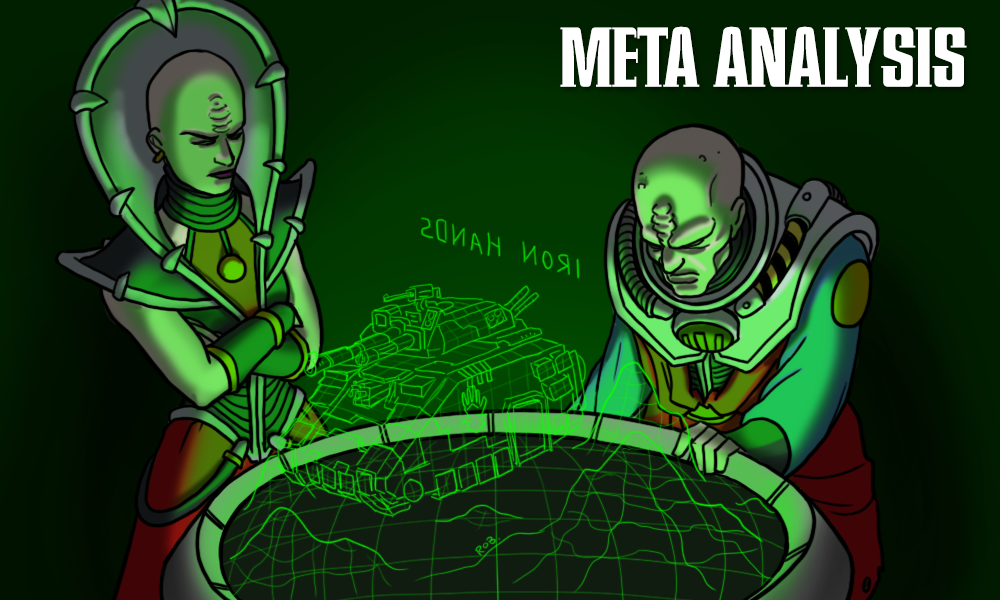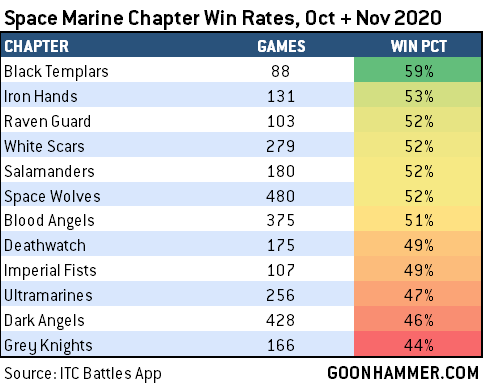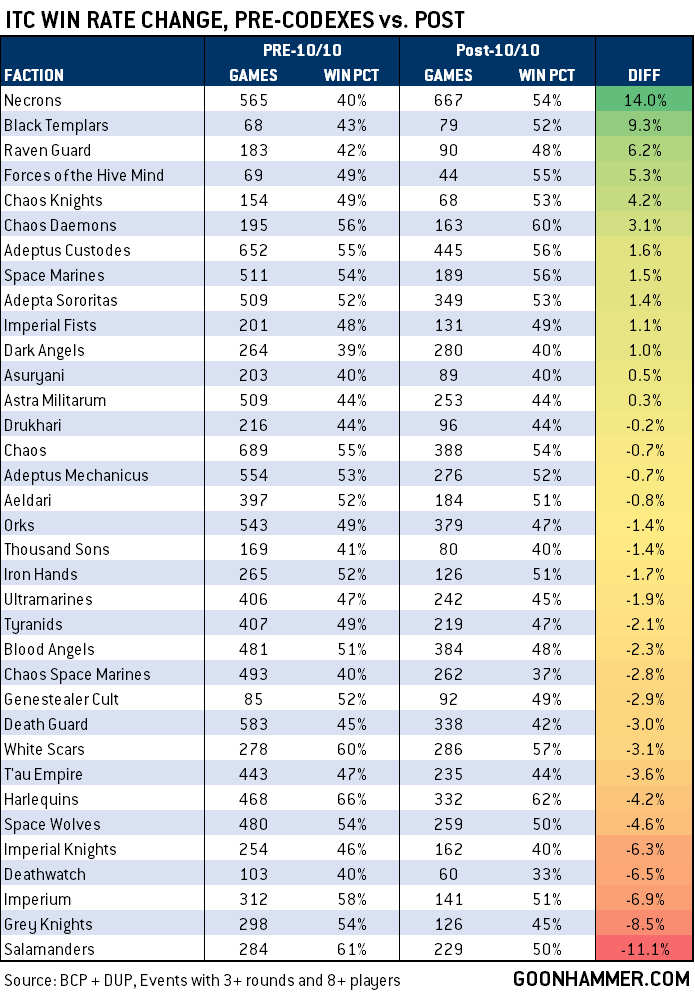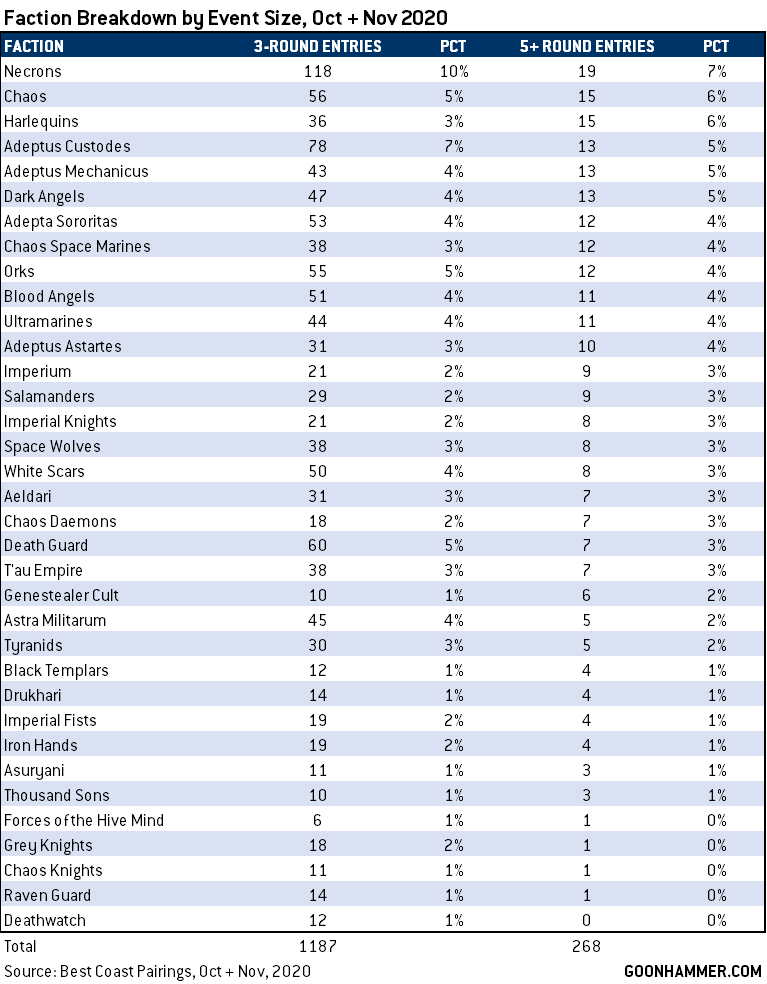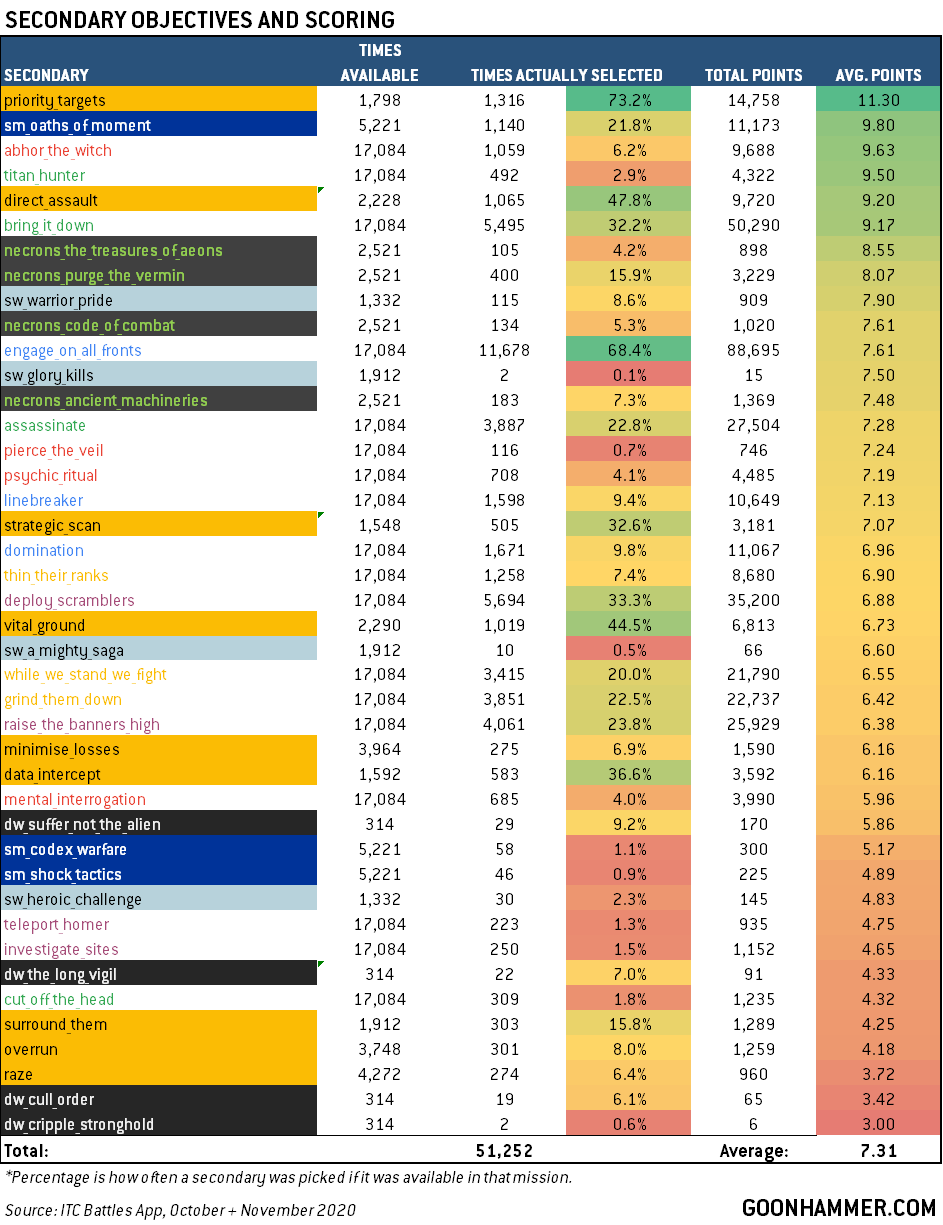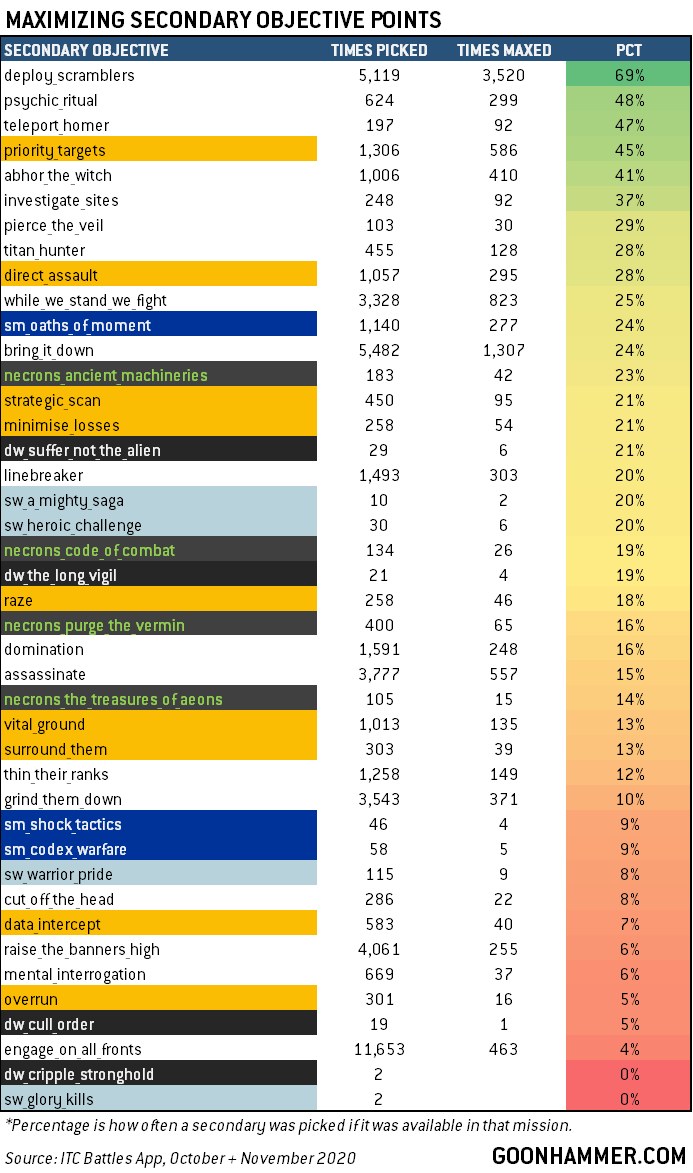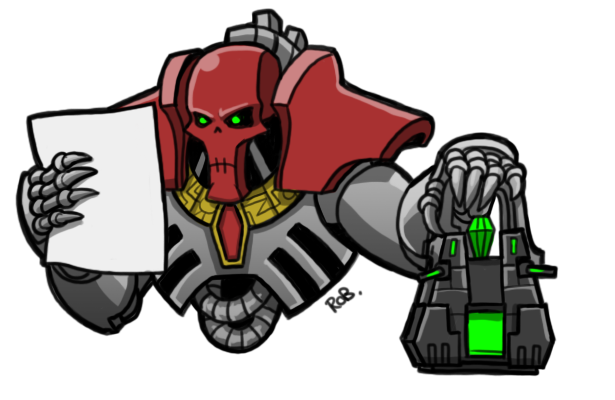Each month, we take a look back at the month that was, looking at gaming data and trends from the past month to identify how 40k is changing and how it affects the way armies play on the table. As we head into December, we’re taking a deeper look at some of the ways the new codexes are changing the meta and what to think about moving forward.
November was a heck of a month, with more (ill-advised) tournament play than any month of 9th edition so far and some major shake-ups to the meta.
In our September and October meta updates, we took a deep look at the relationship between win rates and players taking the first turn, looking at how that affected primary and secondary scoring, and how and why some factions were able to thrive despite those disadvantages. For the most part, we consider that matter to be closed – we’ve laid out what we believe is a very compelling case and while we’ll continue to look at the data to see if the story changes, we’ll be focusing on some other topics this month.
Also we’d like to extend a very special thanks to Peter “The Falcon” Colosimo from 40kstats.com – a fantastic site that we constantly refer to and reference for our own purposes – for helping with the analysis on this month’s Meta Analysis.
Methodology
Thanks to the wonderful efforts of tournament organizers and app developers around the world, we have access to what is essentially every meaningful piece of data around competitive games of 40k. The data in this month’s study comes from three sources:
- The ITC Battles App, a brilliant app for tracking games both in and out of tournaments. In our latest data pull, this gives us data on more than 18 thousand games of 9th edition Warhammer 40,000, with 7,548 of those played since the new Codexes were released on October 10th. Additionally, the app now includes data on which player won the roll-off to go first, for deployment, and subfaction data. If you haven’t used the app, it’s the best way out there to track your practice games and it’s great for tracking games at events.
- Best Coast Pairings/Down Under Pairings – The fine folks at BCP/DUP make the app for collecting and reporting tournament results for ITC events. The BCP/DUP dataset includes data from more than 13,500 games played at events, includes subfaction data, and now tracks game stats through its game scorecard. If you haven’t used the app, it’s worth checking out, and subscribers can access events data and lists for any event run through the app. We couldn’t do our weekly competitive innovations article without this app.
- Tournament Organizers. We’ve had great support from tournament organizers around the world, who’ve helped us out by sending us results for events where the data isn’t being collected in other systems.
Faction Analysis
We already talked about factions in detail in part one of our analysis – Last Week’s 40k Tier List Article by James “One_Wing” Grover. Those were supported by a mix of list analysis, collected data, with a bit of prediction. In this article, we’ll talk about some of the data behind those decisions, and the way things have changed.
The Times, They Are A Changin’
With the release of Codex: Space Marines and Codex: Necrons in mid-October, we’ve officially moved into a new stage of Warhammer 40k’s 9th edition, moving past what could be considered its “Indexhammer” form of FAQ-supported 8th edition books and into a new era of codexes written with 9th edition in mind. If recent announcements have been anything to go by, we’re looking at another year (at least) of breakneck pacing on codexes releases, with new books releasing every month, plus new matched play rules from books like the upcoming War Zone: Charadon, we’re looking at a chaotic time that’s sure to see lots of quick changes in the meta. Alongside the codexes, several other factions also received wargear overhauls to bring their weapons in line with the new 9th edition stats.
In that sense, we can already see major shifts due to the new books. This is most prominent for Space Marine and Necrons, though we’ll see some additional effects for Deathwatch and Space Wolves (but it’s still a little bit too early to have full data on how those supplements have changed things). In the chart below, you can see the difference in pre- and post Codex Release (10/20) win rates for factions in the ITC Battles app:
Let’s start with the biggest change: Since the new Space Marine and Necron codexes dropped in mid-October, we’ve seen a massive shift in win rates for Necrons – 12.8% upward on the whole – to well above 50%. That’s a huge boost for them, and mirrors the success the faction has seen on the ITC stage, which we’ll talk about in a moment. Deathwatch have also seen an uptick, and similar to Necrons have seen more games played, while many of the still-struggling factions have seen their share of games go down – Imperial Knights in particular.
One function that ITC Battles App recently added was subfaction data, allowing us to look at win rates by subfaction. This dataset is pretty small for any faction except space marine chapters, so this month we’ll only be looking at those specific subfactions. In future analyses we may look at Chaos Space Marine legions if we have the chance, and there may be more data on things like Plague Companies.
In what will be a repeated trend with ITC events data from BCP/DUP, we can see that Black Templars are crushing it with the new codex (albeit with the smallest sample size), while Salamanders and White Scars appear to have fallen back down to much more respectable 52% win rates.
Looking at Tournament Data
On that note, we can move to our other dataset. ITC Battles App gives us a great view of practice games and generally mirrors what we see in ITC events, but it’s worth taking a look at that data in its own right. We looked at 3+ round events with 8+ players in Best Coast Pairings and Down Under Pairings to examine how faction win rates changed from pre- to post-Codex releases.
As space marine chapters have been tracked in the ITC as factions for a longer period of time, we can do a comparison to pre- and post-codex win rates that includes them, and from this we can tell the following:
- Black Templars got a big boost from Codex: Space Marines and their Index. My colleague James “One_Wing” Grover already talked about this in his Competitive Innovations in 9th column when he looked at Ben Cherwien’s list. The ability to go hard on damage-dealing melee units and shore up the army’s weaknesses with the Rites of War Warlord Trait saves them a lot of trouble and several key relics like the Ancient Breviary and the Crusader’s Helm give them a big boost.
- Salamanders really felt their Chapter Tactic and unit nerfs. They’re still just fine – a 52% win rate is nothing to sneeze at – but Salamanders aren’t nearly the force they were just a few weeks ago. On the other hand, White Scars are as nasty as ever with a 57% win rate in tournament games.
- If Deathwatch and Dark Angels are poised to climb, it hasn’t happened yet. The new Deathwatch book seems pretty strong, but the delay between its release and events allowing it mean that data on Deathwatch performance is pretty limited and if they’re going to get a bump from the book, it hasn’t happened yet. Likewise for Dark Angels, who seem pretty strong now, but haven’t had that translate yet into widespread success.
In addition to win rates, the number of games played for each faction has also changed. If we look at the share of games played for each faction pre- and post-mid October, we can see how excitement over new books and rules shifts player preferences.
So similar to what we’d previously seen, Necrons got the big boost in games played, and on the Space Marine side, Dark Angels and White Scars have seen minor upticks as generic Space Marine successor chapter use has gone down.
While we’re on that note, it’s worth looking at how the field changes based on size of events – do we see broader compositions at smaller events where players are more likely to be testing options and competition is less fierce? If we compare events with 3 rounds and 8+ players to 5+ round events with 32+ players, we can see some interesting effects:
The key takeaways here are that you’re significantly more likely to play against Necrons, Death Guard, and Custodes at a smaller event, and significantly more likely to play against Harlequins at a larger event with tougher competition.
On an interesting note, overall your odds of playing against Codex: Space Marines armies are about the same regardless of which size event you attend.
Which Factions Depend The Most on Having The First Turn?
Something we began exploring last time around and now have a bit more data on is the difference in faction win rates going first and second. Now that we have more subfaction data in the ITC Battles App dataset, we can look at this difference in win rates since new codexes started dropping mid-October. Factions and subfactions with smaller numbers of games over this time period have been rolled into their larger groups, i.e. “Slaanesh” was rolled up into “Chaos”.
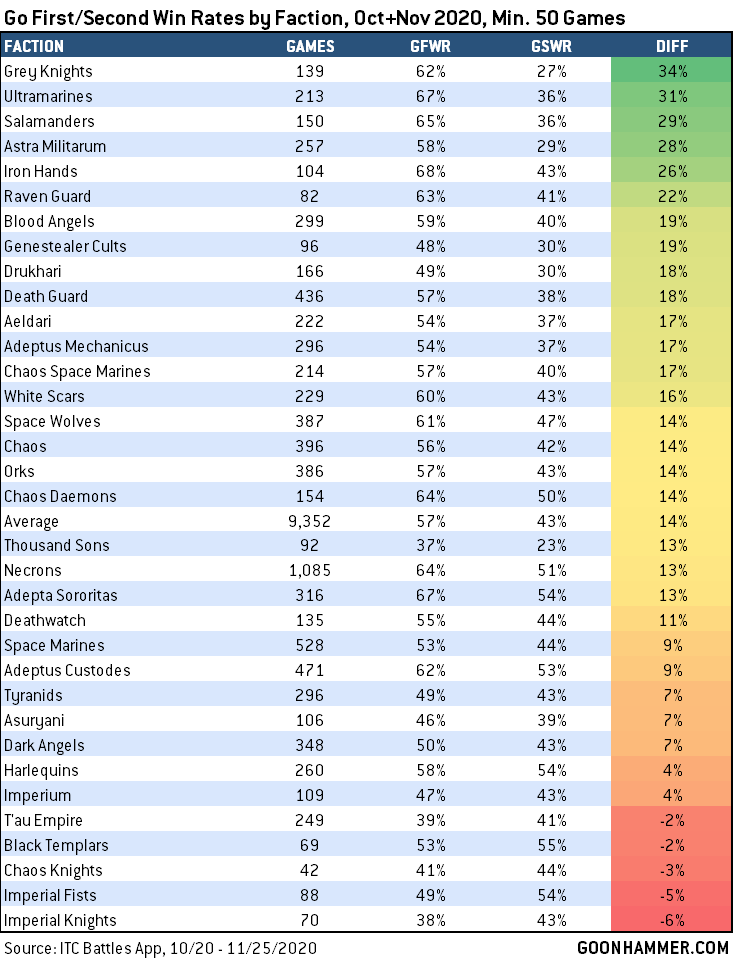 *Note: Chaos Knights have been included for Completeness’ sake
*Note: Chaos Knights have been included for Completeness’ sake
These rates haven’t changed that much from last time, but now we have the ability to add in a meaningful number of games from the Space Marine Chapters to look at how they fare going first and second. The net result is that our data here suggests that Grey Knights are perhaps the army in the game most dependent on acting first, with a massive 34% gulf between first and second turn. Ultramarines and Salamanders also appear to have high discrepancies that are worth keeping an eye on, though they have substantially higher win rates in both categories.
Overall, these numbers haven’t shifted too much from our look at overall faction go first/second win rates last month – Grey Knights were among the top factions for go first/second win differential there as well. On the flip side, this is the first time we’ve seen a legitimate push into higher go second win rates for some factions, though notably four of these are factions with fewer than 100 games played and T’au Empire, who basically lose most games regardless of whether they go first or second.
Secondary Objectives
One major impact of the new codexes is the addition of new secondary objectives. While these have been a mix of everything from good (Oaths of Moment) to awful (Cripple Stronghold) to “holy crap what were they thinking” (Suffer Not the Alien), it’s not yet clear what impact they’ve had, and will continue to have, on competitive play. Using data from the ITC Battles App from November and December, we’re able to get a better idea of both how players are selecting and achieving Secondary Objectives, and which ones better contribute to a win.
Let’s start by looking at the selection rates and average points scored, by secondary objective.
There’s a lot going on here and it isn’t even the whole story! Let’s start by summarizing the major talking points:
- Priority Targets is pretty much a must-pick. The Secondary for the Priority Target mission, Priority Targets is as close as 9th edition secondaries get to “free real estate.” Players choosing this secondary score an average of 11.3 points off it per game, picking it a whopping 72.3 percent of the time, and it’s on the lower side variance-wise, with a standard deviation of about 4 points. It’s also one of the friendlier secondaries to players in a losing position, and among the top secondaries that a losing player is likely to max (29%). That you’ll always have a “home” Priority Objective marker to score and protect and the fact that scoring occurs at the end of your turn means it can be an easy objective to score even if you’re out of position at the start of the turn.
- Oaths of Moment is really good. By far the most powerful of the new codex secondary objectives and the best of those in Codex: Space Marines, Oaths of Moment has a more modest pick rate (21.8%), but is worth an average of 9.8 points and is maxed by players 27% of the time. The combination of having several easy ways to score and being in the No Mercy, No Respite category (which offers little to Space Marines to begin with), makes it even better.
- Abhor the Witch, Titanslayer, and Bring it Down show why they warp the format. Sure, they won’t be active every game, particularly since you can build around not giving up max points to Bring it Down, but when they do get picked – only 6% of the time for Abhor and 3% for Titanslayer, but 32% for Bring it Down – they’re worth an average of more than 9 VP each. Abhor is particularly nasty, since it gets maximized a whopping 41% of the time it’s chosen, making it particularly devastating to armies that are susceptible to it. Comparatively, Assassinate, which usually involves killing models with built-in character protection, is only worth an average of 7.3 VP but it’s also one of the game’s most reliable secondary choices.
- All four Necron secondaries are pretty decent. We have just enough data on the Necron secondary objectives to really talk about them and so far, they’re all worth an average of more than 7 points to the player picking them. That’s pretty good.
- Cut Off The Head is the worst non-mission secondary in the game. Worth an average of only 4.3 points, Cut off the Head is rarely picked and never rewards its player, seeing max points only 8% of the times it’s selected.
On that note, let’s talk about maxing secondaries, since the chart above doesn’t tell the full story. We’ve said before that Deploy Scramblers is a good secondary, but with a max of only 10 points to offer, it has an average score of 6.88 points, well below many other top choices? So why is it a good secondary objective pick? The answer is: It’s very easy to maximize, and it’s all-or-nothing 10 points.
Players choosing Deploy Scramblers are able to maximize it 69% of the time (nice), with players doing so 57% of the time in losses and 81% of the time in wins. So while your cap for Deploy Scramblers is only 10 points, it’s one of the rare secondary objectives where that’s an OK tradeoff given how easy it is to score if you build for it (units can deep strike into an enemy deployment zone and drop a scrambler in the same turn). Psychic Ritual and Teleport Homer are distant seconds here, and this is where we can start to see some interesting value exchanges.
- Engage on All Fronts has potentially the lowest maximization rate of any secondary, owing to the need to score max points on it every turn of the game to max it out, but with an average score of 7.6 points, it’s also one of the game’s most valuable secondary choices. Here, similar to Deploy Scramblers, you have a secondary that won’t usually net you 15 points, but it’s easy enough to earn 10 that it’s worth taking, especially since it combines with other secondaries (such as Deploy Scramblers).
- Again you can see Abhor the Witch make its case here – it’s not on all the time, but when it’s on, your odds of maxing it are pretty good and even if you don’t it’s likely to net you 10 points. This is also a great reason to make sure your army has 0 to 2 psykers if you can help it. Basically, if you aren’t Chaos Daemons, think real hard about whether your army needs that third psyker. Again you can see here how Assassinate avoids being as bad as some of the other kill secondaries, with only a 15% max rate.
- Oaths of Moment and Ancient Machineries are the Codex secondary objectives most likely to be maxed during a game. They also have great average scores, making them probably the strongest picks for each faction overall. Ancient Machineries is also one of the more rewarding secondaries for the losing player.
And while we’re on that topic, there’s one more angle to investigate here. Namely: Which secondaries are “win-more?” That is, which secondaries are more likely to be maxed by a winning player vs. a losing player, and thus are likely to help you win by more points if you’re already in a good position vs. those that are more likely to help you catch up in a bad one?
Let’s look at Secondary maxing rates for the winning vs. losing player.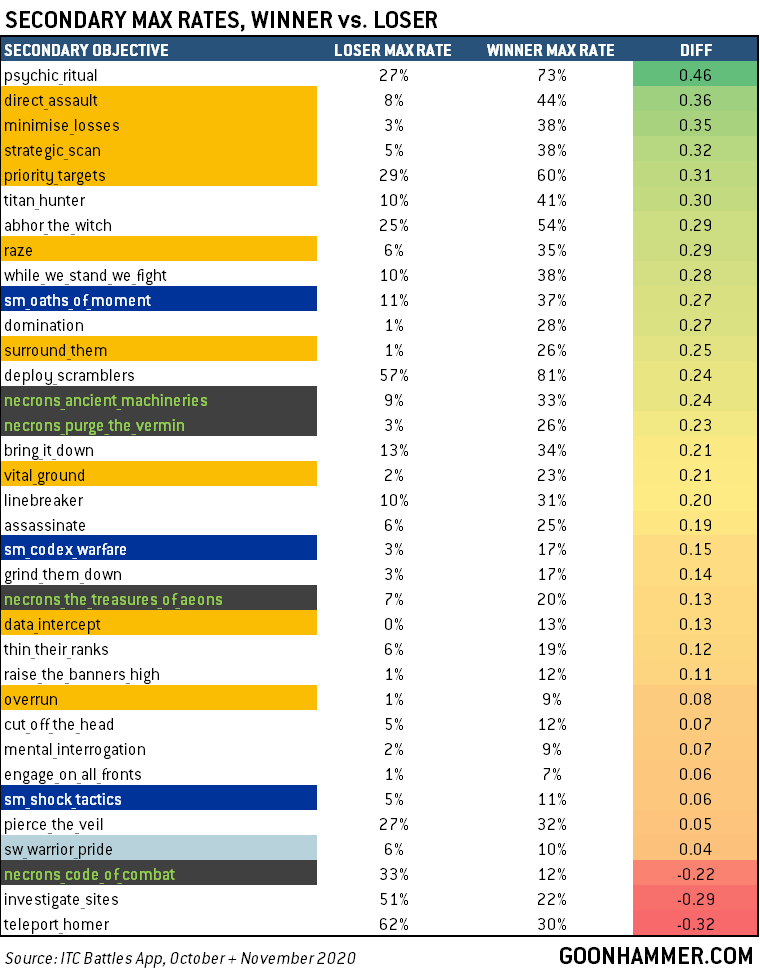
Another big chart but the last one, I promise. Here we have the chances of a player scoring max points for a particular secondary based on whether they won or lost the game. So 73% of winning players who picked Psychic Ritual maxed it out, and only 27% of losing players did. Generally as a philosophy, if a secondary has really high max rates for the winner and poor rates for the loser, it’s “win more,” i.e. maximizing it requires being in a position to win the game already. If it has really high max rates for the loser and really low rates for the winner, it’s probably a bad secondary that encourages you to chase an action that is counter to the act of winning the game otherwise. A secondary need not have equal rates for both to be good.
Some thoughts here:
- Deploy Scramblers and Teleport Homer offer the highest chances of maximizing a secondary to the losing player – 57% and 62%, respectively. Deploy Scramblers is just easy to do and the winning player will max it out 81% of the time. On the other hand, a losing player is more likely to maximize Teleport Homer than a winning player, potentially owing to the need to devote units in an opponent’s deployment zone to completing the same action multiple turns in a row.
- Code of Combat and Investigate Sites are also more likely to be maxed out by the losing player. That they have low max rates for the winner isn’t great and likely marks them as bad picks, and it’s worth wondering if these do better for losing players because pursuing them locks your army out of accomplishing other more important tasks.
- Psychic Ritual is the most win-more secondary in the game. Don’t pick it. If you manage to score your max points on Psychic Ritual, chances are good you’ve already won the game or are in position to. Which makes sense given your opponent at that point has let a psyker character stand in the middle of the table unmolested casting psychic actions for three turns. After Psychic Ritual, Domination and Surround Them are probably the next worst, with only a 1% max rate for the loser.
- Pierce the Veil is a great pick for psychic armies on the maps it’s good on. You’re almost equally likely to max out Pierce the Veil regardless of whether you win or lose, and with an average value of 7.46 points (the vast majority of the time you’ll be able to get it off twice in order to score 8 points). Be aware though that the nature of Pierce means it’s only really good on a few of the maps, and that’s reflected in it being infrequently picked but high scoring.
Does Picking Low-Max Secondaries Cost You?
So we’ve pointed out a few secondary choices that tend to have higher ceilings but potentially higher scoring averages. Does taking these help or hurt you overall? Well, the answer is complicated. Generally speaking, the player with a lower max possible score on secondary points loses about 54% of the time, indicating an advantage for the winner. That’s also true when the differential is only 5 points, so if one player has 45 max secondary points and the other player took Deploy Scramblers.
But isn’t Deploy Scramblers good? Well yeah, but with a caveat – these results will be skewed by many games where it’s possible to max out the kill secondaries, and in those games Deploy Scramblers has a lot less value. In other words, Deploy Scramblers is definitely good a lot of the time, but it’s not going to be nearly as good as games where you or your opponent have a clear path to 45 points through secondaries like Abhor the Witch, Bring Them Down, and Assassinate.
Also it’s worth pointing out that, while there are generally only three secondaries that won’t net you 15 points max, there are a host of others that are very unlikely to max out, such as Engage on All Fronts, Grind Them Down, and Thin Their Ranks. You should worry less about what your maximum possible points are and more about your most likely/easy paths to scoring look like.
That said, definitely avoid taking Raze and Cut off the Head.
Are Faction Secondaries Too Much?
The short answer is “yes.” While we don’t have enough data on the Space Wolves and Deathwatch secondaries yet to make strong determinations and write analyses around those, we can see that Oaths of Moment is one of the best secondaries in the game from an average points standpoint. Looking at games where space marines have had access to their custom secondaries, marine armies picking Oaths of Moment win 53% of their games, compared to only 48% without it and that’s before you remove marine vs. marine games. Space Wolves also have access to Warrior Pride if they’re in a game where Oaths of Moment seems like the wrong choice, and A Mighty Saga also appears to be a more versatile choice for them when other kill secondaries aren’t max-able. This also highlights another major issue, which is that Space Wolves, Blood Angels, Deathwatch, and (soon) Dark Angels all have access to both their secondaries and the Codex secondaries, giving them a significant tactical advantage.
As for the Necron Secondaries, the same thing holds, only they have arguably four very solid secondaries, with three that are good in almost any matchup and one that’s good if you’re running the Silent King.
Which isn’t to say that faction secondaries are necessarily a problem, but Space Marine chapters being able to double-dip likely is, and any army that doesn’t have extra secondaries to choose from is clearly at a competitive disadvantage against those which are. Which isn’t a problem if you’re say, Harlequins or Chaos Daemons, but does mean things have gotten tougher for you if you’re one of the bottom factions.
Next Month: Blood Angels and Death Guard and Missions (Oh my)
That wraps up our look at the meta this month. Stay tuned next month when we’ll look at the early impacts of new books for Blood Angels and Death Guard, plus any new data that comes our way from other sources. We’ll also take a deeper look at missions and how they affect some secondary selections and scoring.
Finally, a huge thanks again to Joshua at ITC Battles app, the wonderful folks at Best Coast Pairings/Down Under Pairings, and the Falcon for helping put this together and really make this the most thorough analysis yet. Y’all rock and we always have a blast jamming these out.
In the meantime, keep making those lists and if you have any questions or comments, drop us a note in the comments below or email us at contact@goonhammer.com.
